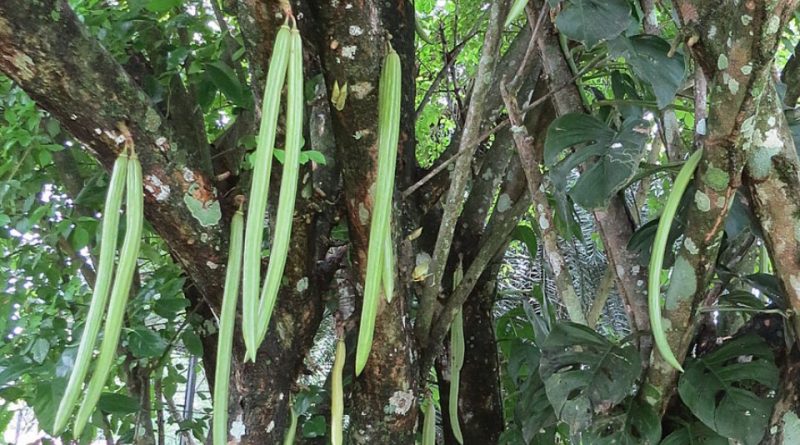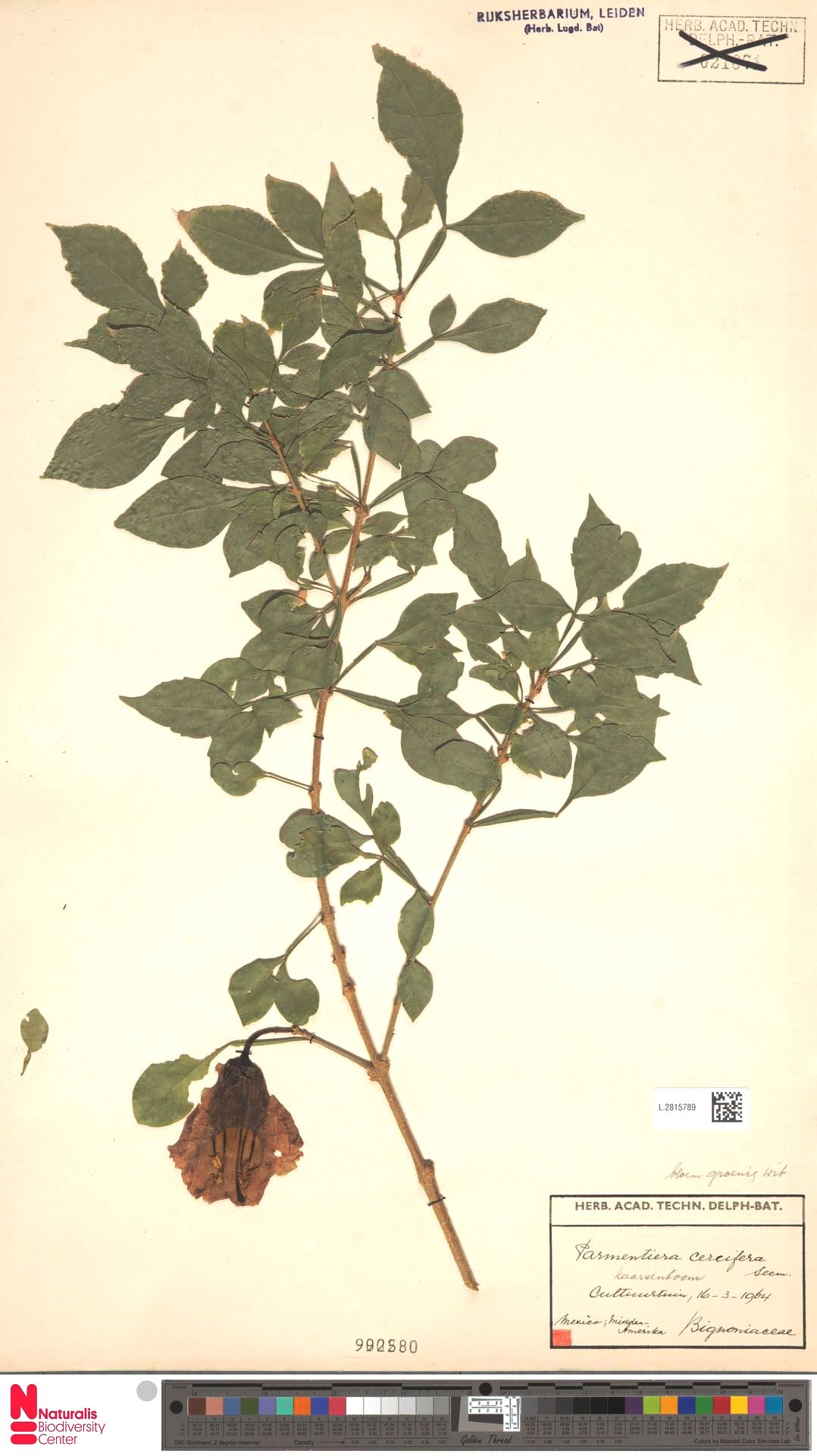Parmentiera cereifera
Parmentiera cereifera
The candle tree (Parmentiera cereifera Seem. 1854) is an arboreal species belonging to the Bignoniaceae family.
Systematic –
From a systematic point of view it belongs to.
Eukaryota domain,
Kingdom Plantae,
Subkingdom Tracheobionta,
Spermatophyta Superdivision,
Division Magnoliophyta,
Class Magnoliopsida,
Subclass Asteridae,
Order Scrophulariales,
Family Bignoniaceae,
Tribe Crescentieae,
Genus Parmentiera,
Species P. cereifera.
Etymology –
The term Parmentiera is in honor of the French agronomist and pharmacist Antoine Augustin Parmentier (1737-1813).
The specific epithet cereifera comes from the combination of the Latin terms “cera”, cera and “fero”, to bear, due to the long hanging fruits similar to candles.
Geographic Distribution and Habitat –
Parmentiera cereifera is an endemic plant of Panama, but it is also a commonly cultivated specimen in botanical gardens.
Its natural habitat is that of the evergreen forests of the Chagres river valley at low altitudes.
Description –
Parmentiera cereifera is an evergreen tree that grows up to 6 meters in height.
It is a small, very branched tree, with smooth or slightly fissured greyish bark.
The leaves are borne by a winged petiole 2.5-6 cm long; they are opposite, trifoliate with obovate-oblong sessile or subsessile leaflets with pointed apex, 2-8 cm long and 1.5-4 cm wide, the terminal slightly larger than the lateral ones, of a shiny light green colour.
The flowers are hermaphroditic and borne on a 1-1.5 cm long peduncle; they are found solitary or in groups of 2-4, directly on the trunk or the main branches (caulifloria), with a spataceous calyx incised laterally up to the base, 2-5 cm long, green in colour, bell-shaped corolla of white or greenish-white colour, 3.5-6 cm in length and 5 cm in diameter, with 5 curved lobes with wavy margins, and 5 stamens, one of which is sterile.
The flowers are pollinated mainly by nectarivorous bats.
The fruit is a cylindrical fleshy berry, 30-60 cm in length and 1-2 cm in diameter, initially green in colour, then yellowish when ripe, with a waxy appearance, persisting for a long time on the plant.
Inside there are numerous oval-shaped seeds, about 3 mm in diameter, flattened, immersed in an edible fibrous pulp.
Cultivation –
Parmentiera cereifera is a tree grown in the West Indies and other tropical regions as an ornamental plant and sometimes also for its edible fruits.
It is a relatively little-known plant sometimes found in parks and botanical gardens in tropical and subtropical countries due to its curious appearance. However, this species has become invasive in northern Australia.
For its cultivation it requires full sun exposure and adapts to a wide variety of soils, as long as it is well drained and kept almost constantly humid.
As an adult it can resist temperatures close to 0 °C, if exceptional and short-lived. In unfavorable climates, young specimens can be grown in pots, to be sheltered in particularly bright greenhouses or winter gardens, in organic soil with the addition of 30% sand or agri-perlite, with minimum winter temperatures above 15 °C; it is considered an excellent subject for bonsai.
Watering must be regular and abundant during the vegetative period, more spaced in winter, but without allowing the substrate to dry out completely.
The plant generally reproduces by seed, in draining organic soil kept constantly humid at a temperature of 25-28 °C, with germination times of 2-4 weeks and first flowering starting from the fifth year of age.
Customs and Traditions –
Parmentiera cereifera is a plant known by some names, including: candle tree (English); árvore-de-velas (Portuguese – Brazil); árbol de cera, árbol de las bujías, árbol vela, candelaro, palo de cera, palo de vela, palo de velas (Spanish).
The fruits of this plant are rarely eaten raw or cooked, they are locally used as livestock feed. Laboratory studies have highlighted the presence of bioactive compounds (flavonoids, saponins, steroids, tannins and terpenoids) in various parts of the plant, worthy of further investigation for possible use in the official pharmacopoeia.
From an ecological point of view, due to the reduction of its habitat, the International Union for Conservation of Nature (IUCN) has included the tree in the red list of species at very high risk of extinction in the wild in the near future (Endangered).
Preparation Method –
Parmentiera cereifera is a plant limited in nature to a relatively limited area and which is used by locals for both edible and medicinal purposes.
The fruits are eaten raw or cooked.
In the medicinal field both the bark and the roots have healing properties.
Guido Bissanti
Sources
– Acta Plantarum – Flora of the Italian Regions.
– Wikipedia, the free encyclopedia.
– GBIF, the Global Biodiversity Information Facility.
– Useful Tropical Plants Database.
– Conti F., Abbate G., Alessandrini A., Blasi C. (ed.), 2005. An annotated checklist of the Italian vascular flora, Palombi Editore.
– Pignatti S., 1982. Flora d’Italia, Edagricole, Bologna.
– Treben M., 2000. Health from the Lord’s Pharmacy, Advice and experiences with medicinal herbs, Ennsthaler Editore.
Photo source:
– https://upload.wikimedia.org/wikipedia/commons/b/ba/Parmentiera_cereifera_%2830244214611%29.jpg
– https://medialib.naturalis.nl/file/id/L.2815789/format/large
Attention: Pharmaceutical applications and food uses are indicated for informational purposes only, they do not represent in any way a medical prescription; we therefore decline any responsibility for their use for healing, aesthetic or food purposes.


